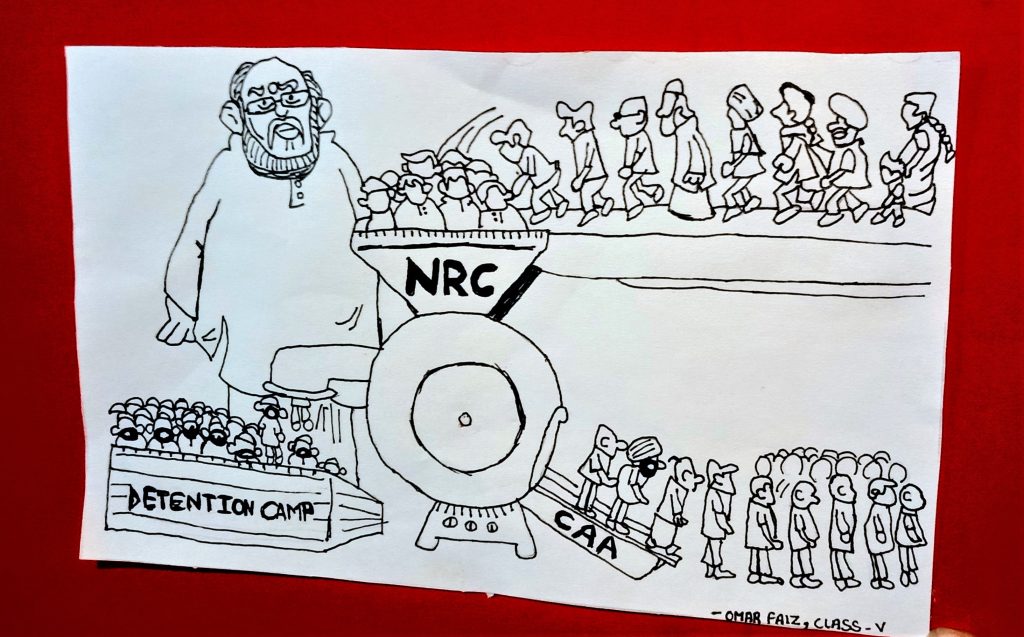The Young Against The New Partition: Why The CAA & NRC Are The Biggest Tests For Independent India
Published @ Indiatimes.com
To view the published version, see
Indiatimes.com

Protest drawing of a student at Shaheen Bagh, December 2019. Photo by author.
The Young Against The New Partition: Why The CAA & NRC Are The Biggest Tests For Independent India
Several public intellectuals, commentators and those who contribute to public opinion in India have compared the current political crisis in India as the biggest test facing us since Independence. At the heart of this crisis is the newly-minted Citizenship Amendment Act (CAA), which proposes to give sanctuary in India to people facing religious persecution in Muslim-majority countries of Pakistan, Bangladesh and Afghanistan.
But this proposition comes with the rider that refugees of all major religions from the three countries will be covered under this law except Islam. This single act of exception changes the entire colour of the new law and militates against the idea of equality enshrined in the Constitution of India. Also, the CAA has been linked, not without reason, to the National Register of Citizens (NRC), which enlists citizens on the basis of ancestry in such a way that one can target minorities easily if so is the malafide bent of the state.
Is this Partition all over again?
But why are the massive public and student protest against these two proposed programmes – one a law, and the other a policy- being billed as the biggest crisis in Independent India? Given the enormous complexity of India’s political life and the attendant set of problems that we face on a regular basis, it is surely not the first time that a major crisis has rocked India.
The Emergency in the mid-1970s, the Mandal agitations in the in 1990, the communal violence in the wake of the demolition of Babri Masjid in early 1990s, the Nirbhaya agitations in 2012, the sudden announcement of demonetization in November 2016, the revoking of Article 370 in Jammu and Kashmir in August 2019 were all potentially restive moments for the Indian public and polity. And they have already made their mark in contemporary Indian history. They have raised serious concerns and have altered lives forever but never ever have the crisis been seen as one potentially disruptive to the idea of India. But why? First, the Constitution of India considers it illegal to offer/reject any republican right to an Indian citizen based on religion, caste and ethnicity. Hence, the very fact of excluding Muslims from applying for Indian citizenship is unconstitutional. Second, the act officially divides the Indian public into religious cohorts, something that the makers of the Constitution had explicitly forbidden by enshrining it into the founding document of the modern Indian Republic.
Every Indian, including the lawmakers, are bound by the laws of the Constitution and in no way does any one party or individual enjoy the right to tamper with its fundamental principles. The Constitution, one must remember, is not a document to be followed in spirit but also, word by word, in letter. There cannot be any logic, whatever the political exigency, that can subvert the Constitution. In this sense, if this Act takes hold it can well be considered as a New Partition, or at least the historical moment that resembles the original Partition of India in 1947.
It is schoolbook knowledge that the Partition of India was carried out on the basis of religion. It was badly planned, clumsily mapped and even more hastily executed. The British left behind not just two states but two (and eventually three) permanently injured and infuriated neighbours with perennially festering wounds. One cannot even begin to name the violence, the trauma and the prolonged difficulties the Partition of India had caused to millions of people in the nations post their divisions. Another ‘Partition’ or thought of it, based on the same logic of religious difference, is hence, savage.
Lessons from history
One must not forget that Britain, as a brute colonial force, did not have any rulebook to refer to, neither were they bound by anything that looked or read like a Constitution. The current government is hence doubly at fault. First, for introducing an amended Act that divides and discriminates openly; and does so by explicitly violating one of the founding values of the Constitution. So, if this act is indeed to be perceived the moment of New Partition, one must remember that unlike the actual Partition, this time India is pitted against itself; and that the dividing power is not a foreign rule but an elected government. The young people of India who are out on the streets today grew up in relative prosperity in the period after liberalization, and have only read about the Partition in books or have heard it in family reminiscences. And yet they have shown unprecedented spontaneity, tenacity and collective gesture of resistance in their acts of protests. The stunned state has responded with relentless brutality, chicanery and lies. Clearly, there are two deeply political positions in India today. On one side is the Indian state that considers its laws unassailable and any act of resistance as treason. On the other side are the Indian people who are declaring civil disobedience as an act of duty to the idea of India. Undeniably, the young people see it as that moment when they need to cross all lines of schooling, fear and self-seeking careerism to converge into the streets again and again. They have perhaps understood that this is the moment when all that they have ever learned from history will come to play. They want to ensure that at least as far as Partition goes, it cannot be allowed to be repeated – whether as tragedy or as farce.
comments for this post are closed